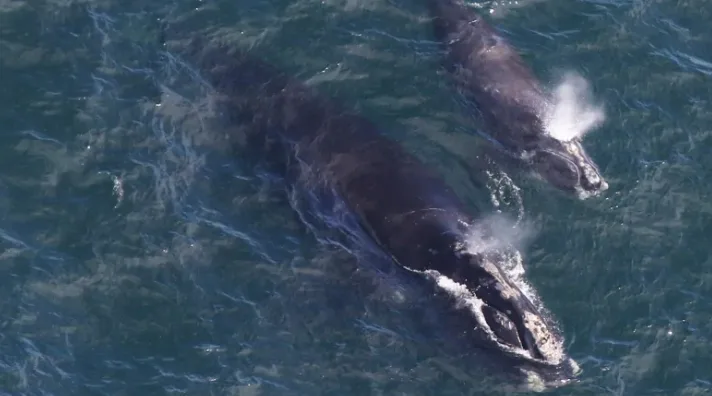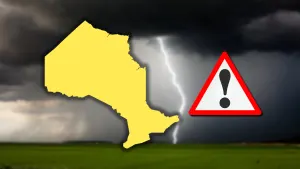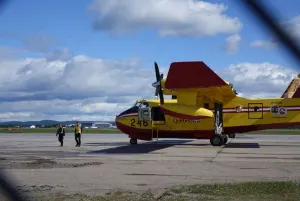
Right whales return to Atlantic Canada with 7 babies in tow
North Atlantic right whales have returned to Canadian waters early this year, and brought with them seven new calves, according to the Department of Fisheries and Oceans, which reported the sighting last week.
The whales, seen in the Gulf of St. Lawrence via surveillance plane, were welcomed as a brief spot of good news for the endangered species, which usually make their first Canadian appearance for the year in June.
"It's really nice to start seeing that we're getting more calves," said Garry Stenson, a DFO research scientist and head of its marine mammal division.
"It's gonna take a lot more before we're gonna be feeling at all comfortable, but it does help to have some. It's a much better view than what we had last year."
No calves were born in 2018, and the overall population is estimated to be just 411 individuals, making it one of the most endangered whale species in the world.
The whale, which historically suffered from humans as the "right" whale to hunt, has been running into trouble again in recent years. Eighteen animals died in 2017, 12 of those in Canadian waters, thought to be the victims of ship collisions or fishing gear entanglements.

A right whale is spotted in the Gulf of St. Lawrence in June 2018. The whales have only recently begun frequenting the area. (Peter Duley/NOAA Fisheries Northeast Fisheries Science Center
'IT'S TOO EARLY TO TELL'
The deaths prompted the federal government to implement fishing restrictions in some areas — restrictions that have since been somewhat loosened — as well as regulations to slow down vessel traffic in shipping lanes.
Scientist, fishermen applaud loosening of whale-protection restrictions
Computer simulator gives new insight into right whale rope entanglements
Stenson said "it's too early to tell" if the restrictions have played a role in the lack of deaths in 2018.
"We really have to look at it over a number of years and see whether or not there's any change in mortality because of this," he said.
Adding to their vulnerability, the slow-moving species is also slow to reproduce. There are about 100 female North Atlantic right whales, said Stenson, and historically, those females could be counted on to give birth about every four years.
But by the 1990s that had stretched to six, and after research was updated in 2017, the interval between babies was pegged at about 10 years.
"We want to see that calving interval decline, back to six years, back to four years, so the females that are there start producing regularly," he told CBC Radio's On The Go, adding that besides ship collisions and getting tangled in nets, the mortality rate for the whales is low.

A North Atlantic right whale calf and its mother are seen April 11 in Cape Cod Bay, near Massachusetts, as they migrate north to Canadian waters. (Amy James/Center for Coastal Studies/NOAA permit 19315-1 via AP)
RESEARCH RAMPING UP
As DFO ramps up its efforts to understand and get ahead of the right whale population problem, scientists admit they don't know that much about the species in the first place, and what they do know is rapidly changing.
The whales, easy to identify thanks to their distinctive white skin patches, usually spend part of spring, summer and fall in the Bay of Fundy and off southwest Nova Scotia.
But that pattern changed in 2015 when they began appearing in the Gulf of St. Lawrence, with Stenson and other scientists suspecting the whales were adapting to changes in the zooplankton populations they feed on.
To get a handle on where the whales are and what they're doing, the summer of 2019 will see a team of scientists from Nova Scotia, New Brunswick, Newfoundland and Labrador and Quebec scour the area, with aerial surveys using planes and drones, as well as ship-based research.
"We're looking at the whole ecology, the whole ecosystem for these whales in our trip, hopefully in the next couple of months," said Andrew Wright, a DFO marine biologist who will be leading the summer's study in the Gulf of St. Lawrence, starting in mid-July.
Scientists will be monitoring sea conditions and nutrient levels to get a snapshot of how healthy the surrounding environment is, said Wright, as well as taking pictures of the whales to get a sense of how well-fed they are.

A 2019 calf, on the left, and its mother, are seen near Florida in January. (Florida Fish and Wildlife Conservation Commission, NOAA permit 20556-01)
UNDERSEA NOISE STRESS
They'll also be taking undersea recordings, and Wright also hopes to tag some whales with a suction cup-like tracker than will also take stock of what sounds the whales are hearing beneath the water.
"We do know that right whales are stressed by ship noise. It's more of a question of how stressful that is for them, and whether or not this is a long-term issue," said Wright.
Scientists are unsure whether the stress issue is a chronic one for the whales, or if it spikes during a close encounter with a ship. Wright's team hopes to answer that question by in a few ways.
One, by tagging the whales to record what they physically do when they encounter a ship. They also plan to employ drones and scoop up samples of blow — that misty mix expelled through the whale's blowholes — and measure the stress hormones within it.
"It's going to be a challenging few weeks that we'll have on the water," Wright said.
"We'll need the weather gods behind us, and just a little bit of luck on our side."
The scientists plan to begin their studies in mid-July and continue to mid-August.
This article was written for the CBC.









